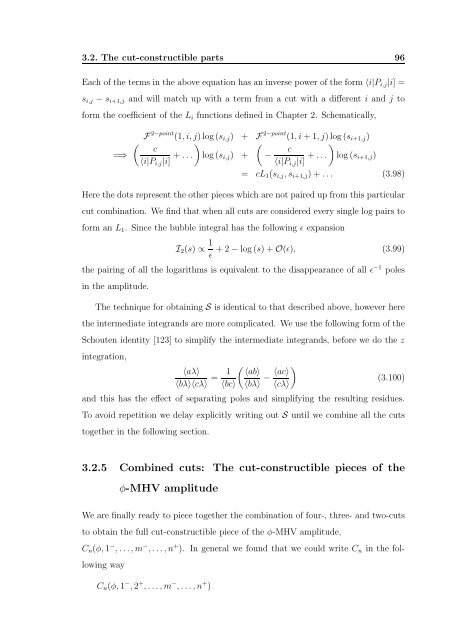Hadronic production of a Higgs boson in association with two jets at ...
Hadronic production of a Higgs boson in association with two jets at ...
Hadronic production of a Higgs boson in association with two jets at ...
You also want an ePaper? Increase the reach of your titles
YUMPU automatically turns print PDFs into web optimized ePapers that Google loves.
3.2. The cut-constructible parts 96Each <strong>of</strong> the terms <strong>in</strong> the above equ<strong>at</strong>ion has an <strong>in</strong>verse power <strong>of</strong> the form 〈i|P i,j |i] =s i,j − s i+1,j and will m<strong>at</strong>ch up <strong>with</strong> a term from a cut <strong>with</strong> a different i and j t<strong>of</strong>orm the coefficient <strong>of</strong> the L i functions def<strong>in</strong>ed <strong>in</strong> Chapter 2. Schem<strong>at</strong>ically,=⇒F 2−po<strong>in</strong>t (1, i, j) log(s i,j ) + F 2−po<strong>in</strong>t (1, i + 1, j) log(s i+1,j )( ) ()c〈i|P i,j |i] + . . . clog (s i,j ) + −〈i|P i,j |i] + . . . log (s i+1,j )= cL 1 (s i,j , s i+1,j ) + . . . (3.98)Here the dots represent the other pieces which are not paired up from this particularcut comb<strong>in</strong><strong>at</strong>ion. We f<strong>in</strong>d th<strong>at</strong> when all cuts are considered every s<strong>in</strong>gle log pairs t<strong>of</strong>orm an L 1 . S<strong>in</strong>ce the bubble <strong>in</strong>tegral has the follow<strong>in</strong>g ǫ expansionI 2 (s) ∝ 1 ǫ+ 2 − log (s) + O(ǫ), (3.99)the pair<strong>in</strong>g <strong>of</strong> all the logarithms is equivalent to the disappearance <strong>of</strong> all ǫ −1 poles<strong>in</strong> the amplitude.The technique for obta<strong>in</strong><strong>in</strong>g S is identical to th<strong>at</strong> described above, however herethe <strong>in</strong>termedi<strong>at</strong>e <strong>in</strong>tegrands are more complic<strong>at</strong>ed. We use the follow<strong>in</strong>g form <strong>of</strong> theSchouten identity [123] to simplify the <strong>in</strong>termedi<strong>at</strong>e <strong>in</strong>tegrands, before we do the z<strong>in</strong>tegr<strong>at</strong>ion,〈aλ〉〈bλ〉〈cλ〉 = 1 ( 〈ab〉〈bc〉 〈bλ〉 − 〈ac〉 )〈cλ〉(3.100)and this has the effect <strong>of</strong> separ<strong>at</strong><strong>in</strong>g poles and simplify<strong>in</strong>g the result<strong>in</strong>g residues.To avoid repetition we delay explicitly writ<strong>in</strong>g out S until we comb<strong>in</strong>e all the cutstogether <strong>in</strong> the follow<strong>in</strong>g section.3.2.5 Comb<strong>in</strong>ed cuts: The cut-constructible pieces <strong>of</strong> theφ-MHV amplitudeWe are f<strong>in</strong>ally ready to piece together the comb<strong>in</strong><strong>at</strong>ion <strong>of</strong> four-, three- and <strong>two</strong>-cutsto obta<strong>in</strong> the full cut-constructible piece <strong>of</strong> the φ-MHV amplitude,C n (φ, 1 − , . . ., m − , . . .,n + ). In general we found th<strong>at</strong> we could write C n <strong>in</strong> the follow<strong>in</strong>gwayC n (φ, 1 − , 2 + , . . .,m − , . . .,n + )
















